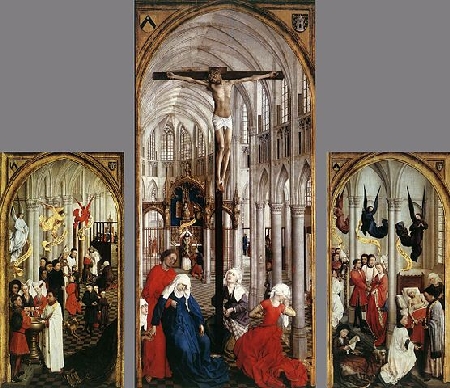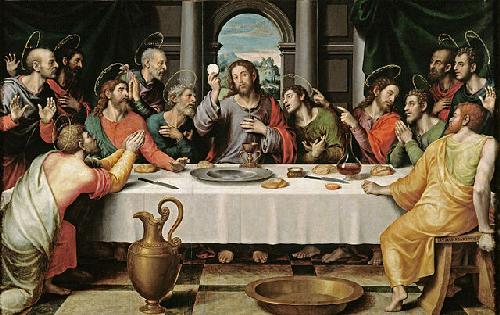The Sacraments

A few Protestant churches include a service of washing feet as Jesus did to his disciples at the Last Supper as an additional sacrament connected to the Service of the Lord's Table. Roman Catholic churches and Eastern Orthodox churches recognize a total of seven sacraments. In addition to Baptism and the Service of the Lord's Table they include:
- confirmation (what you're studying for right now),
- penance (sorrow at your sin, confession of your sin, absolution of your sin, and receiving forgiveness for your sin),
- holy orders (practically the same as our ordination),
- matrimony (marriage within the church), and
- extreme unction (also sometimes called last rites these are the prayers of comfort that are said for or with a person who is near death).
We value the spiritual content of these other rituals and in the case of confirmation, ordination, and marriage we include them as distinct portions of our worshipping life. Penance and extreme unction we include in the general category of prayer for and with other persons. A very shortened form of penance is included as part of our confession of sins and assurance of pardon in the first part of our worship services as part of our gathering in God's name. However, we only consider as sacraments those rituals "instituted by God and commended by Christ."
Many Christians including some Presbyterians use the word sacrament in a broader sense to include a wide variety of actions and experiences in which the material world becomes a way of enriching our spiritual lives. Persons using the word in this fashion, however, almost always recognize a distinction between the sacraments they experience in daily mindfulness and the Sacraments of the Church.
As Presbyterians we believe that
The early Church, following Jesus, took three primary material elements of life—water, bread, and wine—to become basic symbols of offering life to God as Jesus had offered his life. Being washed with the water of Baptism, Christians received new life in Christ and presented their bodies to be living sacrifices to God. Eating bread and drinking wine they received the sustaining presence of Christ, remembered God's covenant promise, and pledged their obedience anew.
The Reformed tradition understands Baptism and the Lord's Supper to be Sacraments, instituted by God and commended by Christ. Sacraments are signs of the real presence and power of Christ in the Church, symbols of God's action. Through the Sacraments, God seals believers in redemption, renews their identity as the people of God, and marks them for service.
Directory for Worship, Book of Order, W-1.3033
Baptism

In the Presbyterian Church, we usually baptize persons by pouring water over their heads. In Scripture, baptism is often associated with running water in rivers or streams. In the ancient church, from what we can tell from images and archaeological evidence, people were often baptized by entering a large basin or pool about three feet deep. The person being baptized would kneel in the pool and either have the water cover them or have water poured over them. Kneeling as a sign of submission was a part of the ritual.
Today many different ways of baptizing are used by various churches. Some churches baptize using enough water to completely cover the new Christian and the person lies back as in a coffin to remind all of us of the death to the old things and the beginning of new life that is part of conversion. In other churches, persons are immersed in the water three times once in the name of the Father, once in the name of the Son, and once in the name of the Holy Spirit. Still other churches baptize much as we do but include anointing with oil and lighting a special candle as part of the ceremony.
In the Presbyterian Church (U.S.A.), we do not re-baptize persons no matter what method or posture has been used as long as the baptism was done with water in the name of the Father, Son, and Holy Spirit. (Matthew 28:19) We may not ourselves choose to use all the symbols included in the earlier baptism, but we do not repeat the baptism because of the even worse symbolism that would exist if we insisted that the promise of God's love didn't count if it wasn't done in our particular way.
When an infant who cannot answer for him or herself is baptized it is important that the parents and the congregation promise to raise the child so that she or he grows up knowing of God's love. This is vitally important because we view baptism like circumcision in the Old Testament as a sign of inclusion into a covenant, an agreement and promise between us and God that relates not just to our own salvation but to the way we will live in community and how we will teach, encourage, pray for, and support one another. It is our practice that
When a child is being presented for Baptism, ordinarily the parent(s) or one(s) rightly exercising parental responsibility shall be an active member of the congregation. Those presenting children for Baptism shall promise to provide nurture and guidance within the community of faith until the child is ready to make a personal profession of faith and assume the responsibilities of active church membership.
Directory for Worship, Book of Order, W-2.3014
The Service of the Lord's Table

In the Service of the Lord's Table like in the service of Baptism, we are taught to use common material objects, the juice of the grape and the broken bread, to both teach us an object lesson and to become for us the ultimate gift of Jesus Christ. These everyday foods become the sign of Jesus' giving his body and blood out of love for us. We understand that just as we receive and sustain human life through eating and drinking ordinary food, we receive and sustain eternal life through eating and drinking the extraordinary food provided by the sacrifice of our Lord. These sacraments are more than symbols; they are ways of actually accomplishing what is symbolized.
Later in this unit we will consider a more detailed analysis of what we do and believe related to communion. However, before we consider the details of the Service of the Lord's Table, let's consider some of the questions about the Service of the Lord's Table
How is Jesus Present at the Lord's Table?
Since at least the Ninth Century there have been debates about what exactly Jesus meant when he said the bread of the communion was his body and the wine was his blood. The most notable of these debates was between Benedictine Monks Radbertus and Ratramnus beginning in 844. Since Jesus words are central to the communion service, the difficulties in explaining what he meant make those debates important then and now. Over time the ways to express what Jesus meant have become part of what distinguishes denominations. Roman Catholics and Orthodox Christians hold to the view that the bread and wine literally are changed although on a level that humans cannot perceive. This view is often called "transubstantiation" or "change of substance." Lutherans believe that although Jesus is present everywhere he especially merges himself with the bread and wine in the service of the Lord's Table. This merging is much as heat is added to a metal bar lying in a fire changing the nature of the bar but leaving it still a metal bar. This view is often called "consubstantiation" or "with the substance." Presbyterians and other members of the Reformed Tradition tend to hold a variety of views on what happens in communion. Theologian Brian Gerrish lists these Reformed theologies concerning the Lord’s Supper
- “symbolic memorialism” where the elements remind us of Christ's sacrifice,
- "symbolic parallelism” where the worshipper's body receives the bread and wine while the worshipper's spirit feeds on Christ, and
- “symbolic instrumentalism” where the elements point to the thing signified and conveying the promised grace.
“The
Lord’s Supper in the Reformed Confessions,”
Theology Today, 23:2
(July 1996) pp. 224-243.
As Presbyterians, we do not strive to make sure everyone understands the service the same way but emphasize the power and encouragement we receive through this service to do good in the world and to not return evil for evil.
How Often Is The Lord's Table Served?
Today it is the practice in most Presbyterian Churches to celebrate (or serve) the Lord's Supper once a month, usually on the first Sunday of the month. This is an increase over serving it once every three months as some of our older members remember from their youth. This is still not what the Reformers thought to be enough or what the early church thought to be enough or what most of the Roman Catholic, Eastern Orthodox, Anglican, or Lutheran churches consider to be enough. John Calvin, the reformer most closely associated with our denomination, believed that it was a great mistake to separate the preaching of the gospel from the Service of the Lord's Table. He believed it was illogical to tell people what they should be doing or believing and not at the same time to empower them with Jesus Christ's gift of the sacrament. He believed that telling people to serve God while not giving them the gifts of God to enable them to serve was like a cruel joke.
The Presbyterian Church (U.S.A.) teaches
The Lord's Supper is to be observed on the Lord's Day, in the regular place of worship, and in a manner suitable to the particular occasion and local congregation. It is appropriate to celebrate the Lord's Supper as often as each Lord's Day. It is to be celebrated regularly and frequently enough to be recognized as integral to the Service for the Lord's Day.
Directory for Worship, Book of Order, W-2.4009
Who Is Invited to the Lord's Table?
You may know that at some churches the celebration of the Lord's Table is limited to members of that specific church or even that specific congregation. This is usually as a way of respecting the communion and not making it open for persons not serious about faith in God to use frivolously. In the Presbyterian Church (U.S.A.), however, we believe
[A]ccess to the Table is not a right conferred upon the worthy, but a privilege given to the undeserving who come in faith, repentance, and love. In preparing to receive Christ in this Sacrament, the believer is to confess sin and brokenness, to seek reconciliation with God and neighbor, and to trust in Jesus Christ for cleansing and renewal. Even one who doubts or whose trust is wavering may come to the Table in order to be assured of God's love and grace in Christ Jesus.
Directory for Worship, Book of Order, W-2.4011a
Around the Table of the Lord, God's people are in communion with Christ and with all who belong to Christ. Reconciliation with Christ compels reconciliation with one another.
Directory for Worship, Book of Order, W-2.4006
We particularly invite parents to bring children to the table so that from their earliest memories children will know they were included in the celebration of God's love for the world. The Lord's Supper should never be about our worthiness to eat a meal prepared by God but about our receiving a gift of God even when we did not understand, or deserve it. In communion we remember that Jesus fellowshipped with sinners like us; we remember that he died for sinners like us; and we remember that has prepared a place for sinners like us. The Lord's Table rightly understood makes us feel humble, grateful, glad, and filled with power to be what we should be.